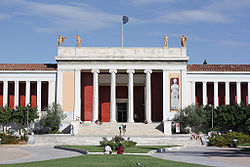National Archeological Museum in Athens, Greece

Although there are 40 museums dotted around the capital, to Athenians there is one which doesn't take its name in vain - "To Museo" - is how the Athenians refer to their greatest house of treasures the National Archaeological Museum. Situated on an easy central Athens trolley route (No 8) this beautiful building has such a plethora of ancient artefacts and art that to see them all properly would take weeks. As it is, visitors can usually only spend several hours before they begin to flag.
The museum was completed in 1889 from plans made by the architect Ludwig Lange and partly modified by Ernst Ziller (famed for the Schliemann Mansion, or House of Ilium on Panepistimiou Street). In this neo classic gem, Greece acquired its first large imposing museum for archaeological finds.
There is much to see but some of the most important finds should be sought out. Unless joining a guided group the halls tolled through, and the first houses the sepulchral amphora'' 760 B.C. its geometric style holding the visitor's attention with its perfectly executed design. The statues of the Kouros, the nude "man-boy" are amply represented in the museum and with their gently menacing smiles and almost too-perfect sturdy limbs, these statues were created in over a century of time, evolving into the Kouros no longer as a man boy but as a man.
The magnificent bronze statue of Poseidon or Zeus of Artemission (460-450 BC) is one of the favourites. Found some sixty five years ago off the Evian coast, this beautiful work is awe-inspiring and shows majesty in both posture and expression. The way ancient Greek artists created the drape or a chiton or a himation (robe) was never matched elsewhere.
The Thera frescoes in the first floor are stunning and their colours not faded by time. The collection of vases is immense, black and red figure vases and the white ground vases or lekythoi, have nearly a hall to themselves.
On the ground floor, the findings from royal grave shafts are Mycenaen and include gold funerary masks and gold cups and the handsome silver shyton in the shape of a bull's head an. Inside galleries, marble statues of the Cycladic civilisation of the 3rd millennium BC sit silently and distinguished by the whiteness of their stone, almost luminous. The numismatic collection is total fascination, the ancient Greeks created the finest coins in the world.
Where to end one's visit depends on the energy of the visitor, there is so much to see and admire. The relief of a fiery horse and a young Negro boy is superb, the coy and playful Aphrodite and Pan, the philosopher's head, all different but all encompassing the main qualities of ancient Greek art, beauty in form and a strong sense of life. Their art lives on for us to enjoy.
Source: Dilos.com